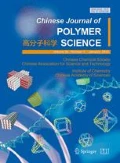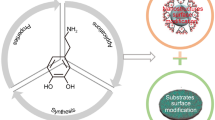Abstract
The infection induced by implantation of biomedical materials may result from the biofilm formation after bacteria attachment. Hence, the antibiofilm surface coating represents a novel technique to improve the antibacterial activity of biomedical materials. The traditional antibiofilm surface coatings exhibited some disadvantages and provided a limited service life. In this work, we used polyethyleneimine grafted 3-maleimidopropionic acid (PEIM) and poly(acrylic acid) grafted 2-furfurylamine (PAAF) to achieve robust and self-healable crosslinked multilayer coatings, employing Layer-by-Layer (LbL) self-assembly technique and Diels-Alder reaction. Then, thiol-terminated poly((3-acrylamidopropyl) trimethylammonium chloride) (PAMPTMA-SH) was grafted onto the crosslinked multilayer coating by thiol-ene click reaction to form a novel multilayer coating (PEIM/PAAF)10-PAMPTMA. We found that this coating showed robust and self-healable activity, and significantly inhibited the bacterial growth and biofilm formation after infection with Escherichia coli (E. coli) and Staphylococcus aureus (S. aureus) by in vitro and in vivo assays for 120 h. In addition, the multilayer coating did not induce significant hemolysis or affect the cell viability of red blood cells. In vivo studies also showed that (PEIM/PAAF)10-PAMPTMA coating efficiently blocked the infiltration of inflammatory cells and gene expression in the mouse skin challenged with E. coli or S. aureus. Taken together, these results showed that the prepared multilayer coating exhibited strong antibiofilm activity and provided a new strategy for the application of highly efficient antibiofilm surface coating of biomedical materials.
Similar content being viewed by others
References
Ding, X. K.; Duan, S.; Ding, X. J.; Liu, R. H.; Xu, F. J. Versatile antibacterial materials: an emerging arsenal for combatting bacterial pathogens. Adv. Funct. Mater. 2018, 28, 19.
Li, C.; Lu, D. Y.; Deng, J. J.; Zhang, X.; Yang, P. Amyloid-like rapid surface modification for antifouling and in-depth remineralization of dentine tubules to treat dental hypersensitivity. Adv. Mater. 2019, 31, 1903973.
Zhao, J.; Qu, Y.; Chen, H.; Xu, R.; Yu, Q.; Yang, P. Improve wound healing in vivo. J. Mater. Chem. B 2018, 6, 4645–4655.
Kang, T.; Banquy, X.; Heo, J.; Lim, C.; Lynd, N. A.; Lundberg, P.; Oh, D. X.; Lee, H. K.; Hong, Y. K.; Hwang, D. S.; Waite, J. H.; Israelachvili, J. N.; Hawker, C. J. Mussel-inspired anchoring of polymer loops that provide superior surface lubrication and antifouling properties. ACS Nano 2016, 10, 930–937.
Baggerman, J.; Smulders, M. M. J.; Zuilhof, H. Romantic surfaces: a systematic overview of stable, biospecific, and antifouling zwitterionic surfaces. Langmuir 2019, 35, 1072–1084.
Zhang, R.; Zhang, L.; Tian, N.; Ma, S.; Liu, Y.; Yu, B.; Pei, X.; Zhou, F. The tethered fibrillar hydrogels brushes for underwater antifouling. Adv. Mater. Interfaces 2017, 4, 1601039.
Hu, X.; Tian, J.; Li, C.; Su, H.; Qin, R.; Wang, Y.; Cao, X.; Yang, P. Amyloid-like protein aggregates: a new class of bioinspired materials merging an interfacial anchor with antifouling. Adv. Mater. 2020, 32, 2000128.
Yang, W.; Zhao, W.; Liu, Y.; Hu, H.; Pei, X.; Wu, Y.; Zhou, F. The effect of wetting property on anti-fouling/foul-release performance under quasi-static/hydrodynamic conditions. Prog. Org. Coat. 2016, 95, 64–71.
Borjihan, Q.; Yang, J.; Song, Q.; Gao, L.; Xu, M.; Gao, T.; Liu, W.; Li, P.; Li, Q.; Dong, A. Povidone-iodine-functionalized fluorinated copolymers with dual-functional antibacterial and antifouling activities. Biomater. Sci. 2019, 7, 3334–3347.
Wu, J.; Yu, C.; Li, Q. Novel regenerable antimicrobial nanocomposite membranes: effect of silver loading and valence state. J. Membr. Sci. 2017, 531, 68–76.
Mitra, D.; Li, M.; Kang, E. T.; Neoh, K. G. Transparent copper-based antibacterial coatings with enhanced efficacy against Pseudomonas aeruginosa. ACS Appl. Mater. Interfaces 2019, 11, 73–83.
Xu, L. C.; Meyerhoff, M. E.; Siedlecki, C. A. Blood coagulation response and bacterial adhesion to biomimetic polyurethane biomaterials prepared with surface texturing and nitric oxide release. Acta Biomater. 2019, 84, 77–87.
Zeng, Q.; Zhu, Y.; Yu, B.; Sun, Y.; Ding, X.; Xu, C.; Wu, Y. W.; Tang, Z.; Xu, F. J. Antimicrobial and antifouling polymeric agents for surface functionalization of medical implants. Biomacromolecules 2018, 19, 2805–2811.
Siedenbiedel, F.; Tiller, J. C. Antimicrobial polymers in solution and on surfaces: overview and functional principles. Polymers 2012, 4, 46–71.
Zhou, C.; Song, H.; Loh, J. L. C.; She, J.; Deng, L.; Liu, B. Grafting antibiofilm polymer hydrogel film onto catheter by SARA SI-ATRP. J. Biomater. Sci., Polym. Ed. 2018, 29, 2106–2123.
Atefyekta, S.; Pihl, M.; Lindsay, C.; Heilshorn, S. C.; Andersson, M. Antibiofilm elastin-like polypeptide coatings: functionality, stability, and selectivity. Acta Biomater. 2019, 83, 245–256.
Gu, J.; Su, Y. J.; Liu, P.; Li, P.; Yang, P. An environmentally benign antimicrobial coating based on a protein supramolecular assembly. ACS Appl. Mater. Interfaces 2017, 9, 198–210.
Wang, M.; Shi, J.; Mao, H.; Sun, Z.; Guo, S.; Guo, J.; Yan, F. Fluorescent imidazolium-type poly(ionic liquid)s for bacterial imaging and biofilm inhibition. Biomacromolecules 2019, 20, 3161–3170.
Yang, W. J.; Tao, X.; Zhao, T. T.; Weng, L. X.; Kang, E. T.; Wang, L. H. Antifouling and antibacterial hydrogel coatings with self-healing properties based on a dynamic disulfide exchange reaction. Polym. Chem. 2015, 6, 7027–7035.
Wei, T.; Tang, Z.; Yu, Q.; Chen, H. Smart antibacterial surfaces with switchable bacteria-killing and bacteria-releasing capabilities. ACS Appl. Mater. Interfaces 2017, 9, 37511–37523.
Tian, J.; Liu, Y.; Miao, S.; Yang, Q.; Hu, X.; Han, Q.; Xue, L.; Yang, P. Amyloid-like protein aggregates combining antifouling with antibacterial activity. Biomater. Sci. 2020.
Wang, Z. H.; Fei, G. X.; Xia, H. S.; Zuilhof, H. Dual water-healable zwitterionic polymer coatings for anti-biofouling surfaces. J. Mater. Chem. B 2018, 6, 6930–6935.
Yuan, P.; Qiu, X.; Wang, X.; Tian, R.; Wang, L.; Bai, Y.; Liu, S.; Chen, X. Substrate-independent coating with persistent and stable antifouling and antibacterial activities to reduce bacterial infection for various implants. Adv. Healthcare Mater. 2019, 8, e1801423.
Wang, Q.; Wang, L.; Gao, L.; Yu, L.; Feng, W.; Liu, N.; Xu, M.; Li, X.; Li, P.; Huang, W. Stable and self-healable LbL coating with antibiofilm efficacy based on alkylated polyethyleneimine micelles. J. Mater. Chem. B 2019, 7, 3865–3875.
Wei, Z.; Yang, J. H.; Zhou, J.; Xu, F.; Zrínyi, M.; Dussault, P. H.; Osada, Y.; Chen, Y. M. Self-healing gels based on constitutional dynamic chemistry and their potential applications. Chem. Soc. Rev. 2014, 43, 8114–8131.
Hillewaere, X. K. D.; Du Prez, F. E. Fifteen chemistries for autonomous external self-healing polymers and composites. Prog. Polym. Sci. 2015, 49–50, 121–153.
Jin, J.; Cai, L.; Jia, Y. G.; Liu, S.; Chen, Y.; Ren, L. Progress in self-healing hydrogels assembled by host-guest interactions: preparation and biomedical applications. J. Mater. Chem. B 2019, 7, 1637–1651.
Yang, Q. M.; Liu, Y. C.; Chen, L. X.; Yang, P. Study on the amyloidlike fibrinogen-based Nanofilm. Acta Polymerica Sinica (in Chinese) 2020, 51, 890–900.
Fan, F.; Zhou, C.; Wang, X.; Szpunar, J. Layer-by-Layer assembly of a self-healing anticorrosion coating on magnesium alloys. ACS Appl. Mater. Interfaces 2015, 7, 27271–27278.
Zhang, X.; Xu, Y.; Zhang, X.; Wu, H.; Shen, J.; Chen, R.; Xiong, Y.; Li, J.; Guo, S. Progress on the layer-by-layer assembly of multilayered polymer composites: strategy, structural control and applications. Prog. Polym. Sci. 2019, 89, 76–107.
Zhu, X. Y.; Loh, X. J. Layer-by-layer assemblies for antibacterial applications. Biomater. Sci. 2015, 3, 1505–1518.
Wei, T.; Zhan, W. J.; Cao, L. M.; Hu, C. M.; Qu, Y. C.; Yu, Q.; Chen, H. Multifunctional and regenerable antibacterial surfaces fabricated by a universal strategy. ACS Appl. Mater. Interfaces 2016, 8, 30048–30057.
Wang, B. L.; Ren, K. F.; Chang, H.; Wang, J. L.; Ji, J. Construction of degradable multilayer films for enhanced antibacterial properties. ACS Appl. Mater. Interfaces 2013, 5, 4136–4143.
Zhu, X.; Guo, S.; Janczewski, D.; Velandia, F. J.; Teo, S. L.; Vancso, G. J. Multilayers of fluorinated amphiphilic polyions for marine fouling prevention. Langmuir 2014, 30, 288–296.
Min, H.; Qian, W.; Zhao, W.; Zhao, C. S. Substrate-independent ultrathin hydrogel film as antifouling and antibacterial layer for microfiltration membrane anchored via layer-by-layer thiol-ene “click” reaction. J. Mater. Chem. B 2018, 6, 3904–3913.
Cai, T.; Li, M.; Neoh, K. G.; Kang, E. T. Preparation of stimuli responsive polycaprolactone membranes of controllable porous morphology via combined atom transfer radical polymerization, ring-opening polymerization and thiol-yne click chemistry. J. Mater. Chem. 2012, 22, 16248–16258.
Song, H. Y.; Ngai, M. H.; Song, Z. Y.; MacAry, P. A.; Hobley, J.; Lear, M. J. Practical synthesis of maleimides and coumarin-linked probes for protein and antibody labelling via reduction of native disulfides. Org. Biomol. Chem. 2009, 7, 3400–3406.
Chen, X. C.; Ren, K. F.; Zhang, J. H.; Li, D. D.; Zhao, E.; Zhao, Z. J.; Xu, Z. K.; Ji, J. Humidity-triggered self-healing of microporous polyelectrolyte multilayer coatings for hydrophobic drug delivery. Adv. Funct. Mater. 2015, 25, 7470–7477.
Abreu, C. M. R.; Mendonça, P. V.; Serra, A. C.; Popov, A. V.; Matyjaszewski, K.; Guliashvili, T.; Coelho, J. F. J. Inorganic sulfites: efficient reducing agents and supplemental activators for atom transfer radical polymerization. ACS Macro Lett. 2012, 1, 1308–1311.
Mendonça, P. V.; Konkolewicz, D.; Averick, S. E.; Serra, A. C.; Popov, A. V.; Guliashvili, T.; Matyjaszewski, K.; Coelho, J. F. J. Synthesis of cationic poly((3-acrylamidopropyl)trimethyl-ammonium chloride) by SARA ATRP in ecofriendly solvent mixtures. Polym. Chem. 2014, 5, 5829–5836.
Chen, X. C.; Huang, W. P.; Ren, K. F.; Ji, J. Self-healing label materials based on photo-cross-linkable polymeric films with dynamic surface structures. ACS Nano 2018, 12, 8686–8696.
Chen, D.; Wu, M.; Li, B.; Ren, K.; Cheng, Z.; Ji, J.; Li, Y.; Sun, J. Layer-by-layer-assembled healable antifouling films. Adv. Mater. 2015, 27, 5882–5888.
Liu, Y. L.; Lee, H. C. Preparation and properties of polyhedral oligosilsequioxane tethered aromatic polyamide nanocomposites through Michael addition between maleimide-containing polyamides and an amino-functionalized polyhedral oligosilsequioxane. J. Polym. Sci., Part A: Polym. Chem. 2006, 44, 4632–4643.
Asha, A. B.; Chen, Y.; Zhang, H.; Ghaemi, S.; Ishihara, K.; Liu, Y.; Narain, R. Rapid mussel-inspired surface zwitteration for enhanced antifouling and antibacterial properties. Langmuir 2018, 35, 1621–1630.
Surman, F.; Riedel, T.; Bruns, M.; Kostina, N. Y.; Sedlakova, Z.; Rodriguez-Emmenegger, C. Polymer brushes interfacing blood as a route toward high performance blood contacting devices. Macromol. Biosci. 2015, 15, 636–646.
Hänni-Ciunel, K.; Findenegg, G. H.; von Klitzing, R. Water contact angle on polyelectrolyte-coated surfaces: effects of film swelling and droplet evaporation. Soft Mater. 2007, 5, 61–73.
DeLongchamp, D. M.; Hammond, P. T. Highly ion conductive poly(ethylene oxide)-based solid polymer electrolytes from hydrogen bonding layer-by-layer assembly. Langmuir 2004, 20, 5403–5411.
Li, Y. X.; Pan, T. Z.; Ma, B. H.; Liu, J. Q.; Sun, J. Q. Healable antifouling films composed of partially hydrolyzed poly(2-ethyl-2-oxazoline) and poly(acrylic acid). ACS Appl. Mater. Interfaces 2017, 9, 14429–14436.
Bazaka, K.; Jacob, M. V.; Chrzanowski, W.; Ostrikov, K. Antibacterial surfaces: natural agents, mechanisms of action, and plasma surface modification. RSC Adv. 2015, 5, 48739–48759.
Chin, W.; Zhong, G.; Pu, Q.; Yang, C.; Lou, W.; De Sessions, P. F.; Periaswamy, B.; Lee, A.; Liang, Z. C.; Ding, X.; Gao, S.; Chu, C. W.; Bianco, S.; Bao, C.; Tong, Y. W.; Fan, W.; Wu, M.; Hedrick, J. L.; Yang, Y. Y. A macromolecular approach to eradicate multidrug resistant bacterial infections while mitigating drug resistance onset. Nat. Commun. 2018, 9.
Bauer, M.; Lautenschlaeger, C.; Kempe, K.; Tauhardt, L.; Schubert, U. S.; Fischer, D. Poly(2-ethyl-2-oxazoline) as alternative for the stealth polymer poly(ethylene glycol): comparison of in vitro cytotoxicity and hemocompatibility. Macromol. Biosci. 2012, 12, 986–998.
Xu, M.; Khan, A.; Wang, T.; Song, Q.; Han, C.; Wang, Q.; Gao, L.; Huang, X.; Li, P.; Huang, W. Mussel-inspired hydrogel with potent in vivo contact-active antimicrobial and wound healing promoting activities. ACS Appl. Bio. Mater. 2019, 2, 3329–3340.
Acknowledgments
This work was financially supported by the Natural Science Foundation of Jiangsu Province (No. BK20180963) and the Natural Science Foundation of the Jiangsu Higher Education Institutions of China (No. 19KJD430001).
Author information
Authors and Affiliations
Corresponding author
Electronic Supplementary Information
Rights and permissions
About this article
Cite this article
Zhou, C., Zhou, JT., Sheng, CJ. et al. Robust and Self-healable Antibiofilm Multilayer Coatings. Chin J Polym Sci 39, 425–440 (2021). https://doi.org/10.1007/s10118-021-2513-3
Received:
Accepted:
Published:
Issue Date:
DOI: https://doi.org/10.1007/s10118-021-2513-3




